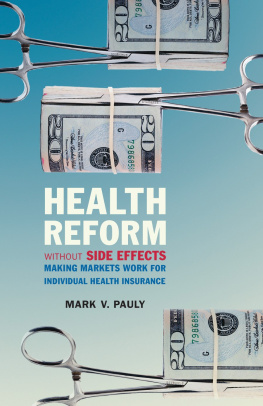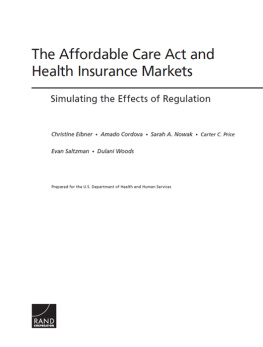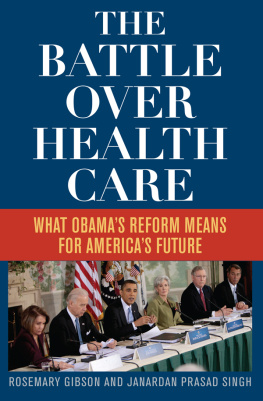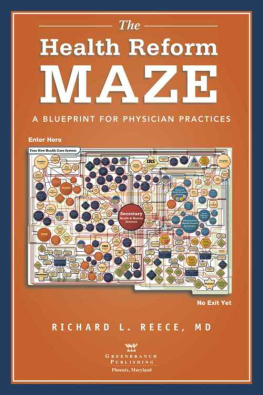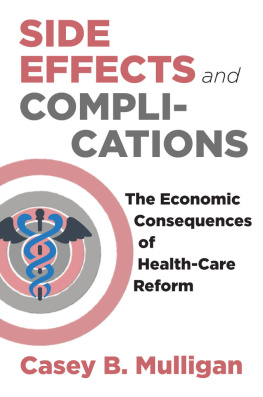The Hoover Institution gratefully acknowledges the following individuals and foundations for their significant support of the Working Group on Health Care Policy and this publication:
LYNDE AND HARRY BRADLEY FOUNDATION
THE HEALEY FAMILY FOUNDATION
HEALTH REFORMWITHOUTSIDE EFFECTS
MAKING MARKETS WORK FOR INDIVIDUAL HEALTH INSURANCE
MARK V. PAULY
HOOVER INSTITUTION PRESS
STANFORD UNIVERSITY
STANFORD, CALIFORNIA
The Hoover Institution on War, Revolution and Peace, founded at Stanford University in 1919 by Herbert Hoover, who went on to become the thirty-first president of the United States, is an interdisciplinary research center for advanced study on domestic and international affairs. The views expressed in its publications are entirely those of the authors and do not necessarily reflect the views of the staff, officers, or Board of Overseers of the Hoover Institution.
www.hoover.org
Hoover Institution Press Publication No. 580
Hoover Institution at Leland Stanford Junior University, Stanford, California 94305-6010
Copyright 2010 by the Board of Trustees of the Leland Stanford Junior University
All rights reserved. No part of this publication may be reproduced, stored in a retrieval system, or transmitted in any form or by any means, electronic, mechanical, photocopying, recording, or otherwise, without written permission of the publisher and copyright holders.
First printing 2010
16 15 14 13 12 11 10 9 8 7 6 5 4 3 2 1
Manufactured in the United States of America
The paper used in this publication meets the minimum requirements of the American National Standard for Information SciencesPermanence of Paper for Printed Library Materials, ANSI/NISO Z39.48-1992.

Cataloging-in-Publication Data is available from the Library of Congress.
ISBN-13: 978-0-8179-1044-0 (cloth. : alk. paper)
ISBN-13: 978-0-8179-1043-3 (e-book)
ISBN: 978-0-8179-1046-4 (electronic)
Contents
Foreword
Health care in the United States has made remarkable advances during the past sixty years. Dramatic improvements in diagnostic and therapeutic strategies, medical technologies, pharmaceuticals, and surgical procedures have extended the length and greatly improved the quality of life. Progress in the treatment of cardiovascular disease has reduced by more than 50 percent the U.S. death rate from heart attacks, accounting for nearly all the increases in the expected life span in the United States since 1950. Also, mainly as a result of the development of combination antiretroviral therapies for the treatment of AIDS, at least three million years of life have been cumulatively saved in the United States since 1989.
Despite such extraordinary progress, however, U.S. health care faces serious challenges. The problem is not so much that health care spending is high but that a significant portion of that spending fails to provide good value. As spending grows, an increasing number of people are priced out of the market for insurance. The fiscal burden of federal and state health care entitlement programs, such as Medicare and Medicaid, can no longer be sustained without either deep reductions in other public programs or sharply higher taxes. Diverting both public and private resources from more-productive uses has become a serious problem.
The debate over the direction of U.S. health care policy is occupying center stage in the domestic policy arena and will during the coming years. The promise of future medical advances stemming from the mapping of the human genome, nanotechnology, and other innovations is bright. But progress will require us to transcend the terms of the current debate, which are often expressed as the competing goals of universal insurance and cost control. The fundamental challenge is to devise public policies that enable more Americans to get better value for their health care dollar and foster appropriate innovation that extends and improves life. Key principles that guide policy formation should include the central role of individual choice and competitive markets in financing and delivering health services, individual responsibility for health behaviors and decisions, and appropriate guidelines for government intervention in health care markets.
The current core membership of the Hoover Institutions Working Group on Health Care Policy includes Scott W. Atlas, John F. Cogan, R. Glenn Hubbard, Daniel P. Kessler, Mark V. Pauly, and Charles E. Phelps.
JOHN RAISIAN
Tad and Dianne Taube Director,
Hoover Institution,
Stanford University
Stanford, California
Acknowledgments
I would like to thank those at the Hoover Institution, in particular John Cogan and Daniel Kessler, who supported and collaborated with me on this project. Special appreciation goes to Director John Raisian for creating the Working Group on Health Care Policy that provides a voice in the current policy debate on health care reform. I would also like to thank Henry Bergquist for excellent research assistance, Rob Liebenthal for useful discussions of the actuarial literature, and Bradley Herring for data on the distribution of the population by risk levels.
Health Reform without Side Effects
Making Markets Work for Individual Health Insurance
MARK V. PAULY
Private health insurance in the United States protects most of the population against the risk of high medical care spending, but the extent of that protection has been declining for at least a decade. The reason for the decline appears to be no mystery: overall health insurance premiums for given coverage have been rising rapidly while consumer incomes have been near stagnant; consumers with little more to spend are increasingly reluctant to spend it on something with a rapidly growing price. But this simple story of prices growing relative to incomes is not quite right, and one piece of evidence arguing for a more nuanced approach is the well-known, widely varying susceptibility to this problem across the population. Most Americans are still getting good insurance protection for good medical care (at least in terms of how they perceive their care), but for a sizeable fraction things are getting worse; not everything is broken, but some things for some people definitely are.
One of the flash points for this stressed system is the availability of insurance for consumers who do not find it easy to access the dominant form of private insurance. Most people are offered insurance related to their job, and most still take it. But increasingly large numbers of workers have jobs where coverage is not offered, or where the terms under which it is offered do not induce them to take it. It is the erosion of job-based coverage that is the main problem. There is an alternative to job-based insurance: consumers could buy health insurance in the same way they buy other kinds of insurance voluntarily, as individual consumers, from private insurance firms. A small fraction (about 7% of the nonelderly population or 10% of those who have private insurance) do buy in this way.
However, the current individual insurance market is generally thought to not work well, less well, in most views, than even the misfiring employment-based market. In the individual market consumers tend to pay a lot for what they get, and, even with that, may worry about not being able to get and keep these overpriced products at all. Precisely because many of the uninsured appear to be permanent dropouts from the employment-based system, attention has turned to the development of an improved individual insurance alternative.



